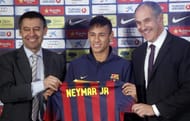“I do not know how much money I have”, Cristiano Ronaldo, recipient of a weekly salary in excess of the cost of his Lamborghini Aventador, was reported saying according to a report by The Mirror. Not only does his weekly wage afford him the possibility of a new, swanky supercar each week, but his Real Madrid contract also has a buyout clause of 1.5 billion $. To put things into perspective, if Cristiano Ronaldo is to leave Real Madrid, then he will have to be purchased for an amount equivalent to half of Portugal’s national defense budget.
Ronaldo, who currently holds the record for being the most expensive transfer of all time, has been joined by the likes of Gareth Bale, Luis Suarez, James Rodriguez and Neymar among several others, who have also been purchased for astronomical sums of money, some of which are greater than the GDPs of entire nations. ‘Where does all that money go?’, you may wonder. Read on to find out exactly what takes place in these bizarrely high transfers.
The transfer fee
The transfer fee is, simplistically and supposedly, the sum paid by the suitor club to the parent club of the player in question, to acquire his services. Therefore, it is implied that the transfer fee must be paid from the club acting as buyer, to the club acting as a seller, which, by the sound of it, is an extremely straightforward process, simple enough to be understood by us quotidians as one entailing zero complexities or minutiae. If only things were as true as they sound!
The transfer fee, is, in actuality, not just the amount paid from one club to the other, but also that paid by the club to all parties involved and uninvolved – the player’s father and mother, the youth academy, the agent, a third party, stadium administration, tax authorities and who knows what else.
The transfer of Neymar to Barcelona is a paradigm case of such, for there have been so many different figures claiming to be the ‘true’ cost of Neymar’s transfer, some by unreliable Spanish newspapers, some by reputed news agencies and some by Barcelona’s president(s). To whom the 47 million / 56 million / 95 million went is as good a guess as this week’s lottery, the lottery being the likelier guess of the two.
According to Raul Sannlehi, who spoke on behalf of Barcelona on this matter, a total of €57.1 million was spent on recruiting Neymar to Camp Nou, of which 40 million was the remuneration to the player’s father’s agency (N&N), and 17 million € was paid to Santos, the Brazilian’s parent club. In addition to this, €56.7 million was paid to Neymar and his agent, totaling up to a gargantuan 113 million.
The BBC and Spanish daily El Mundo have each presented different versions of this, but what all three versions have in common is the fact that Santos received only 17 million, a measly fraction of the ‘transfer fee’ (which, as stated earlier, is supposed to be the amount paid by one club to the other), and that Neymar’s father received more than twice that amount. Hardly what you’d call a ‘transfer fee’; more like a schoolboy’s scholarship.
The buy-out and release clause
A much-discussed subject over recent years, the buyout and release clause have become an essential component of the contract of a reputed player. While not identical in meaning, both clauses run on the principle that if a club makes a bid above the stipulated release price for a particular player, the parent club is bound to allow the player in contention and the suitor club to enter into a contract negotiation. In a nutshell, the buyout and release clause both enable a player to decide independently whether or not he wants to move to the club that triggers the clause by making a bid equal to or above his buyout or release price.
In theory, this concept works just fine as the parent club sets the player’s release price sky-high, usually well above the actual worth of the player. This allows the parent club to fend off any impending swoops from potential suitors for their prized possession, and in case they do lose their prized possession, they will be rewarded with a big, fat and often undeserving cheque in the process. Virtually, that’s a win-bigger-win situation. So what could possibly go wrong?
After all, Diego Costa, Felipe Luis, Luis Suarez, Mario Goetze, Edinson Cavani and Radamel Falcao got the moves they wanted, their parent clubs got the dough they wanted, and the suitors got the players they wanted. What more can you ask for? Everyone’s happy!
But it might so happen that clubs agree to sell for much less than the release clause. Take Nemanja Matic’s case – although his buyout clause was £37 million, due to Benfica being under financial duress, he was sold to Chelsea for £22 million.
The release clause has often blown up in the faces of all three parties involved. Let me allude to some well-publicised transfers to explain this better.
First, and most notably is the Luis Suarez transfer fiasco, which witnessed Luis Suarez being treated like a prisoner (not completely unjustified), Arsene Wenger being atypically and curiously extravagant by offering an entire pound extra to Liverpool, and Liverpool looking like a bunch of babbling baboons, after being humiliated by Wenger’s travesty. The Uruguayan sabre-tooth’s buy-out clause counted for zilch as Arsenal, despite triggering the clause, were shunned. This left Arsene Wenger, who had been fighting tooth and nail to land Suarez, piqued.
The explanation provided by Liverpool for not allowing Suarez the move despite his buyout clause being triggered was that the clause had been signed in ‘good faith’. Violating and encroaching the rights of their very own star player and disrespecting and shunning a revered rival manager for no apparent reason apparently oozed oodles of good faith from the side of the warm Merseysiders.
A slightly more peculiar instance of the buy-out clause leaving a bad taste in the mouth of all parties concerned was the case of Fernandinho. The diminutive Brazilian’s contract at Shakhtar Donetsk included a £40.5 million buyout clause, which Manchester City were reluctant to fork out. The Ukrainian club, similarly, were not willing to settle for a penny less than the amount they had demanded.
With the two clubs at an impasse and Fernandinho’s future at stake, it was the player’s remarkable munificence that stitched the deal together, as he provided the disputed £4 million from his own pocket on behalf of Manchester City. The deal was sealed at 34 million, £4 million of which Fernandinho shelled out himself. Fernandinho had become a Sky Blue, no thanks to his lofty buyout clause, but he was poorer by almost an entire year’s earnings, all thanks to his void buyout clause.
Not only is the buyout clause often void, it is also downright ridiculous in the case of some players. As was mentioned earlier, Cristiano Ronaldo has a buyout clause demanding €1 billion; yes, you read that right. Lionel Messi comes a not-so-close second at €250 million, a whole 4 times less.
If, say, Ronaldo does want away from the Bernebeu, and his release clause, for whatever imaginary reason, holds true, then Real Madrid will be forcing him to stay, imprisoning him, even. And while, with his signature on the clause, it will hold up in a court of law and for all other intents and purposes, the fact will remain that he is being held against his own will, imprisoned. And when somebody is held in imprisonment against their own will, it makes them a slave. And, to quote Abraham Lincoln, “If slavery is not wrong, nothing is wrong.” Not even buyout clauses that promise juicy bills.
The fine print
Transfers, especially high-profile ones, must have fine print reminiscent of our investment advertisements: ”All mutual funds are subject to market risks. Please read the offer document carefully before investing.” If only Roman Abramovich had read the document carefully before investing all that money on Fernando Torres.
On a more serious note though, teams do often resort to Machiavellian tactics, and add fine print in the form of various shrewd clauses, without being considerate enough to lend the player or club reading the contract a magnifying glass.
Southampton seemed to have pulled off a coup after having reportedly included a clause in Alex Oxlade Chamberlain’s sale to Arsenal stating that Arsenal would be required to pay them £10,000 every time Chamberlain plays for over 20 minutes. However, Southampton chose the wrong person to pick a pecuniary battle with, as Arsene Wenger, known to be frugal, negated this clause with his legendary ‘71st minute’ introduction of the Englsihman on a regular basis. Now that’s what you call a coup de maitre.
According to reports, Barcelona have included a sensational ‘bite-clause’ in Luis Suarez’s recently concluded transfer. The Spanish side’s newest acquisition must make sure he never misses a meal again as he could pay a fine up to £3 million, if he does indulge in any form of tooth-sinking while on the field. Well, you know what they say: “If you can’t beat ‘em, eat ‘em.’ And if you eat ‘em, pay for ‘em.
Summary
To summarise, transfers involve a lot of to and fro between clubs, and there is a lot that goes on behind the scenes, most of which does not include the contractual clauses – buy-out or release. All of it comes down in the end to how much both the teams are willing to give in, such that both of them profit.



